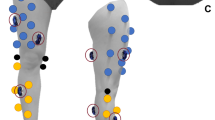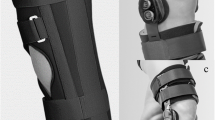Abstract
Gait alterations after ACL reconstruction have been reported in the literature. The current study examined a group of 14 patients who all had an ACL reconstruction with a patellar tendon autograft. Kinetic and kinematic data were obtained from the knee during walking. The flexion-extension deficit (FED) calculated from the angular difference between maximal flexion and maximal extension during the stance phase in the ACL-reconstructed and the normal knee was measured. We investigated whether these alterations in gait are related to quadriceps strength and residual laxity of the knee. It may be that patients modify their gait patterns to protect the knee from excessive anterior translation of the tibia by reducing the amount of extension during stance. On the other hand, persistent quadriceps weakness may also cause changes in gait patterns as the quadriceps is functioning as an important dynamic stabilizer of the knee during stance. Results showed that patients had a significantly higher FED value (4.9±4.0) than a healthy control group in a previous study (1.3±0.9). This is caused mainly by an extension deficit during midstance. External extension moments of the knee (TZMAX were significantly lower in the current patients group than in a healthy control group (TZMAX −0.27±0.19 Nm/kg in patients vs. −0.08±0.06 Nm/kg in controls). There were no significant correlations between quadriceps strength and gait analysis parameters. Furthermore no correlation was found between the amount of laxity of the knee and gait. The relevance of this study lies in the fact that apparently the measured gait alterations cannot be explained solely by often used biomechanical indicators such as laxity and strength. The measured gait alterations may be a result of the surgical procedure with subsequent modified motor programming.








Similar content being viewed by others
References
Anderson MA, Gieck JH, Perrin D, Weltman A, Rutt R, Denegar C (1991) The relationships among isometric, isotonic and isokinetic concentric and eccentric quadriceps and hamstrings force and three components of athletic performance. J Orthop Sports Phys Ther 14:114–120
Andriacchi TP, Birac D (1993) Functional testing in the anterior cruciate ligament-deficient knee. Clin Orthop 288:40–47
Bach BR, Jones GT Hager CA (1995) Arthrometric results of arthroscopically assisted anterior cruciate ligament reconstruction using autograft patellar tendon substitution. Am J Sports Med 23:179–185
Barber SD, Noyes FR, Mangine RE, McCloskey JW, Hartman W (1990) Quantitative assessment of functional limitations in normal and anterior cruciate ligament deficient knees. Clin Orthop 255:204–214
Beard D, Soundarapandian R, O’Connor J, Dodd C (1996) Gait and electromyographic analysis of anterior cruciate ligament deficient subjects. Gait Posture 4:83–88
Berchuk M, Andriacchi TP, Bach BR, Reider B (1990) Gait adaptions by patients who have a deficient anterior cruciate ligament. J Bone Joint Surg Am 72:871–877
Carter TR, Edinger S (1999) Isokinetic evaluation of anterior cruciate ligament reconstruction: hamstring versus patellar tendon. Arthroscopy 15:169–172
Ciccotti M, Kerlan R, Perry J, Pink M (1994) An electromyographic analysis of the knee during functional activities. II. The anterior cruciate ligament-deficient and reconstructed profiles. Am J Sports Med 22:651–658
Daniel DM, Stone ML, Sachs R, Malcolm L (1985) Instrumented measurement of anterior knee laxity in patients with acute anterior cruciate ligament disruption. Am J Sports Med 13:401–407
Delitto A, Irrgang JJ, Harner CD, Fu FH (1993) Relationship of isokinetic peak torque and work to one legged hop and vertical jump in ACL reconstructed knees. Phys Ther 73:85
Engelhardt M, Reuter I, Freiwald J (2001) Alterations of the neuromuscular system after knee surgery. Eur J Sports Traum Rel Res 23:75–81
Ferber R, Osternig LR, Woollacott MH, Wasielewski NJ, Lee JH (2002) Gait mechanics in chronic ACL deficiency and subsequent repair. Clin Biomech 17:274–285
Freiwald J, Jager A, Starker M (1993) EMG-assisted functional analysis within the scope of follow-up of arthroscopically managed injuries of the anterior cruciate ligament. Sportverletz Sportschaden 7:122–128
Freiwald J, Reuter I, Engelhardt M (1999) Neuromuscular and motor system alterations after knee trauma and knee surgery. A new paradigm. In: Lehmann (ed) Overload, performance incompetence and regeneration in sport. Kluwer, New York, pp 81–100
Freiwald J, Engelhardt M (2002) Status of motor learning and coordination in orthopedic rehabilitation. Sportorthop Sporttraum 18:5–11
Karlsson J, Lundin O, Lossing IW, Peterson L (1991) Partial rupture of the patellar ligament. Results after operative treatment. Am J Sports Med 19:403–408
Keays SL, Bullock-Saxton J, Keays AC (2000) Strength and function before and after anterior cruciate ligament reconstruction. Clin Orthop 373:174–183
Kovaleski JE, Heitman RJ, Andres DPS, Gurchiek LR, Pearsall AW IV (2001) Relationship between closed-linear-kinetic and open-kinetic-chain isokinetic strength and lower functional performance. J Sport Rehabil 10:196–204
Lewek M, Rudolph K, Axe M, Snyder-Mackler L (2002) The effect of insufficient quadriceps strength on gait after anterior cruciate ligament reconstruction. Clin Biomech 17:56–63
Liu W, Maitland ME (2000) The effect of hamstring muscle compensation for anterior laxity in the ACL-deficient knee during gait. J Biomech 33:871–879
Mittlmeier T, Weiler A, Sohn T, Kleinhans L, Mollbach S, Duda G, Sudkamp NP (1999) Functional monitoring during rehabilitation following anterior cruciate ligament reconstruction. Clin Biomech 14:576–584
Natri A, Jarvinen M, Latvala K, Kannus P (1996) Isokinetic muscle performance after anterior cruciate ligament surgery. Long-term results and outcome predicting factors after primary surgery and late-phase reconstruction. Int J Sports Med 17:223–228
Noyes FR, Barber SD, Mangine RE (1991) Abnormal lower limb symmetry determined by function hop test after anterior cruciate ligament rupture. Am J Sports Med 19:513–518
Roberts CS, Rash GS, HonakerJT, WachowiakMP, Shaw JC (1999) A deficient anterior cruciate ligament does not lead to quadriceps avoidance gait. Gait Posture 10:189–199
Rudolph KS, Eastlack ME, Axe MJ, Snyder-Mackler L (1998) Movement patterns after anterior cruciate ligament injury: a comparison of patients who compensate well for the injury and those who require operative stabilization. J Electromyogr Kinesiol 8:349–362
Schmalz T, Blumentritt S, Wagner R, Gokeler A (1998) Gait analysis of patients within one year after anterior cruciate ligament reconstruction. Phys Med Rehabil Kurortmed 8:1–8
Schmalz T, Blumentritt S, Wagner R, Junge R (1998) Evaluation with biomechanical gait analysis of various treatment methods after rupture of the anterior cruciate ligament. Sportverletz Sportschaden 12:131–137
Schmalz T, Freiwald J, Greiwing A, Köcher L, Ludwig H, Blumentritt S (2001) Mechanical and electromyographical gait parameters in the course of rehabilitation afetr anterior cruciate ligament reconstruction. Eur J Sports Traum Rel Res 23:146–151
Sekiya I, Muneta T, Ogiuchi T, Yagishita K, Yamamoto H (1998) Significance of the single-legged hop test to the anterior cruciate ligament-reconstructed knee in relation to muscle strength and anterior laxity. Am J Sports Med 26:384–388
Shelbourne KD, Nitz P (1990) Accelerated rehabilitation after anterior cruciate ligament reconstruction. Am J Sports Med 18:292–299
Shelbourne KD, Foulk DA (1995) Timing of surgery in acute anterior cruciate ligament tears on the return of quadriceps muscle strength after reconstruction using an autogenous patellar tendon graft Am J Sports Med 23:686–689
Snyder-Mackler L, Delitto A, Baily SL, Stralka SW (1995) Strength of the quadriceps femoris muscle and functional recovery after reconstruction of the anterior cruciate ligament. J Bone Joint Surg Am 77:1166–1173
Snyder-Mackler L, Fitzgerald KG, Bartolozzi AR, Cicotti MG (1997) The relationship between passive joint laxity and functional outcome after anterior cruciate ligament injury. Am J Sports Med 25:191–195
Timoney JM, Inman WS, Quesda PM, Sharkey PF, Barrack RL, Skinner HB, Alexander AH (1993) Return of normal gait patterns after cruciate ligament reconstruction. Am J Sports Med 21:887–889
Yasuda K, Ohkoshi Y, Tanabe Y, Kaneda K (1992) Quantitative evaluation of knee instability and muscle strength after anterior cruciate ligament reconstruction using patellar and quadriceps tendon. Am J Sports Med 20:471–475
Wilk KE, Andrews JR (1992) Current concepts in the treatment of anterior cruciate ligament disruption. J Orthop Sports Phys Ther 15:279–293
Wilk KE, Keirns MA, Andrews JR, Clancy WG, Arrigo CA, Erber DJ (1991) Anterior cruciate ligament reconstruction rehabilitation: a six month follow-up of isokinetic testing in recreational athletes. Iso Exerc Sci 1:36–43
Wilk KE, Romaniello WT, Soscia SM, Arrigo CA, Andrews JR (1994) The relationship between subjective knee scores, isokinetic testing and functional testing in the ACL-reconstructed knee. J Orthop Sports Phys Ther 20:60–73
Witvrouw E, Bellemans J, Verdonk R, Cambier D, Coorevits P, Almqvist F (2001) Patellar tendon versus doubled semitendinosus and gracilis tendon for anterior cruciate ligament reconstruction. Int Orthop 25:308–11–20
Author information
Authors and Affiliations
Corresponding author
Rights and permissions
About this article
Cite this article
Gokeler, A., Schmalz, T., Knopf, E. et al. The relationship between isokinetic quadriceps strength and laxity on gait analysis parameters in anterior cruciate ligament reconstructed knees. Knee Surg Sports Traumatol Arthrosc 11, 372–378 (2003). https://doi.org/10.1007/s00167-003-0432-1
Received:
Accepted:
Published:
Issue Date:
DOI: https://doi.org/10.1007/s00167-003-0432-1




